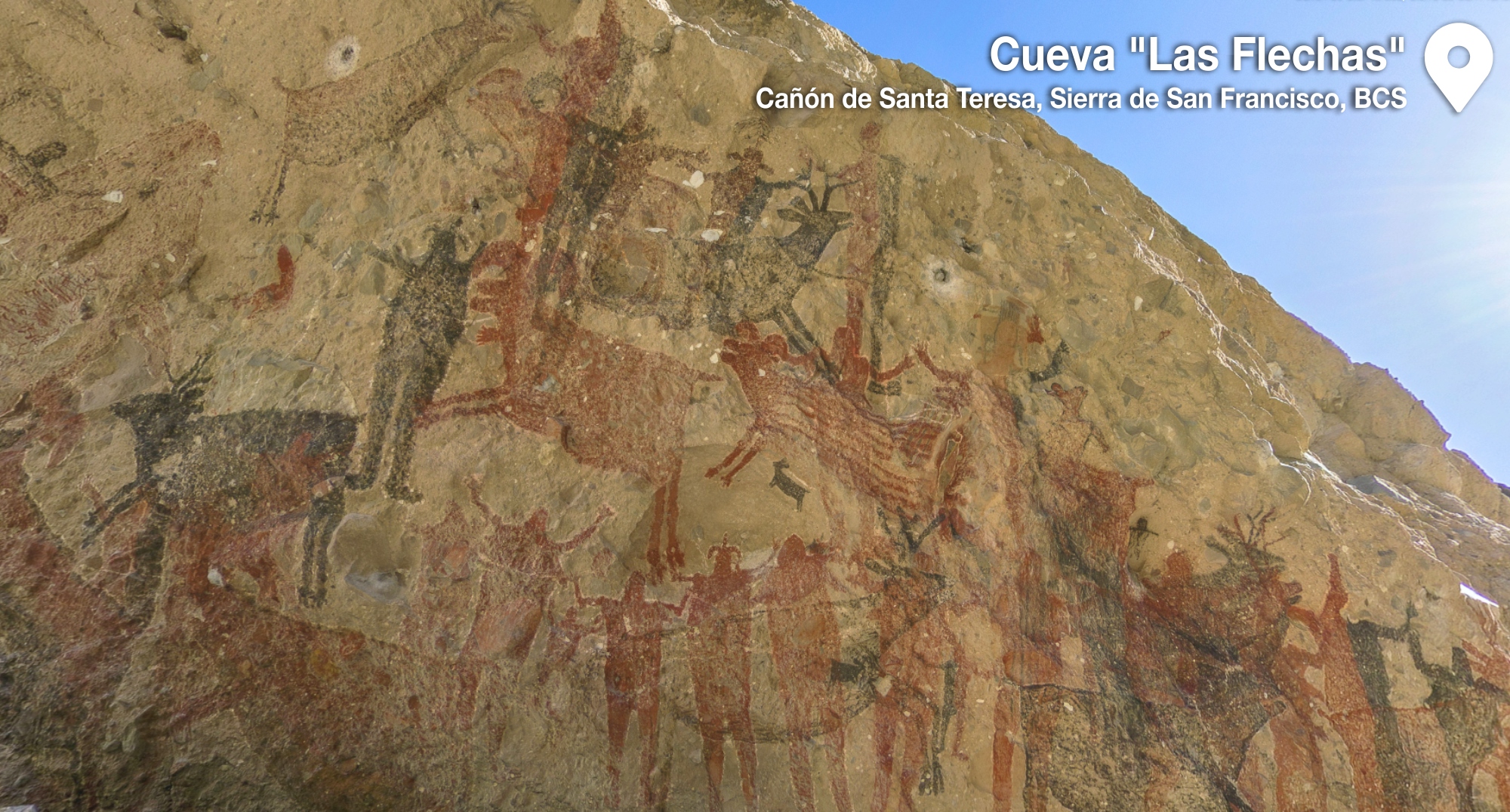Cueva Las Flechas

Las Flechas
Este sitio forma parte del conjunto de pinturas rupestres del cañón de Santa Teresa de la sierra de San Francisco, y su nombre se debe a que el lienzo de la pared rocosa describe a unas figuras humanas flechadas, aparentemente una representación femenina y otra masculina. Estas pinturas están entre las de mayor atracción visual de la región por varias razones. Una de ellas es la limpieza de su factura que sugiere haber sido elaborada en una sola ejecución. A diferencia de otras, ésta no fue repintada, por lo que su lectura visual es de las más claras. Por esta razón, cuando se dio la inscripción como patrimonio mundial fue el sitio que más se difundió oficialmente por medio de carteles. Quienes supieron de la existencia de este sitio, así como de las otras pinturas del conjunto del cañón de Santa Teresa, fueron los primeros rancheros de la sierra de San Francisco, cuando comenzaron a poblarla gracias a Buenaventura Arce, un californio fundador del tronco de los Arce, que ahora sigue floreciendo en los oasis de esa sierra y de donde han salido los guías que conducen a los visitantes que se atreven a incursionar hasta la profundidad de los cañones.
MIRADAS SOBRE LA PINTURA
Algunos autores de libros sobre las pinturas rupestres, y también muchísimos visitantes que tienen la oportunidad de conocer algunas de ellas, miran en las imágenes rupestres lo que consideran la obviedad de una cacería, una guerra, la evidencia visual de la violencia, el sacrificio ritual, la iniciación sexual de los jóvenes, así como la vida reproductiva; también hay quienes han buscado otras lecturas relacionadas con eventos astronómicos ocurridos hace miles de años, como por ejemplo la explosión de una estrella, una supernova que se dice mantuvo al mundo iluminado durante más seiscientas noches a partir del 4 de julio de 1054. Sin embargo, la interpretación para este lienzo de la cueva de Las Flechas sigue pendiente a pesar de que es uno de los sitios más visitados, fotografiados y atrayentes de la sierra.
THE ARROWS
This site is part of the group of cave paintings in the
canyon of Santa Teresa in the San Francisco mountain range, and its name is due
to the fact that the canvas on the rock wall describes some human figures,
apparently a female and a male representation. These paintings are among the most
visually attractive in the region for several reasons. One of them is the
cleaning of your invoice that suggests having been prepared in a single
execution. Unlike others, it was not repainted, so its visual reading is one of
the clearest. For this reason, when it was registered as a world heritage site,
it was the site that was most officially disseminated through posters. Those
who knew about the existence of this site, as well as the other paintings of
the whole of the canyon of Santa Teresa, were the first ranchers of the San
Francisco mountain range, when they began to populate it thanks to Buenaventura
Arce, a Californian founder of the trunk of the Maple, which now continues to
flourish in the oases of that mountain range and where the guides that lead
visitors who dare to venture into the depths of the canyons have emerged.
LOOKS ON THE PAINT
Some authors of books on cave paintings, and also many visitors who have the opportunity to meet some of them, look at the cave images what they consider the obviousness of a hunt, a war, the visual evidence of violence, ritual sacrifice , the sexual initiation of young people, as well as reproductive life; There are also those who have searched for other readings related to astronomical events that occurred thousands of years ago, such as the explosion of a star, a supernova that is said to have kept the world illuminated for more than six hundred nights as of July 4, 1054. However , the interpretation for this canvas of the cave of Las Flechas is still pending although it is one of the most visited, photographed and attractive sites in the mountains.
Detalles
Lugar: Mulegé, Mulegé
Dirección: Camino a San Francisco de la Sierra, Km 36, Mulegé, Baja California Sur
Página web: Sendarupestre.cultura-bcs.gob.mx

